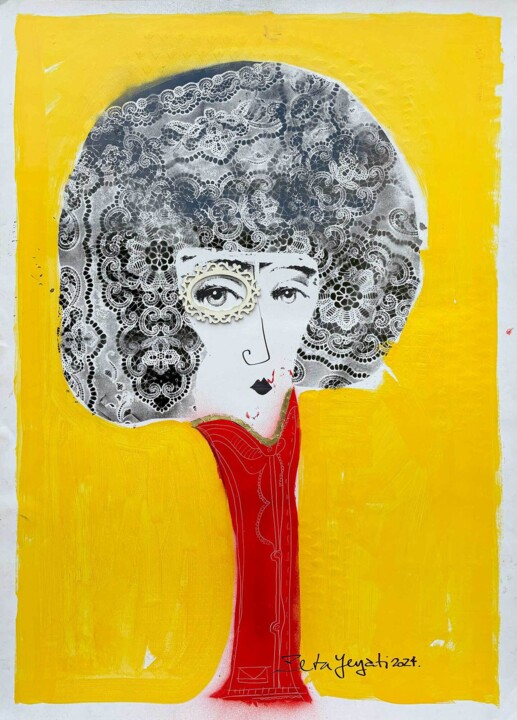






让我们知道您是否想看到这件艺术品的更多照片!
- 工作的背面 / 工作的一面
- 细节 / 签名 / 艺术品的表面或纹理
- 情境中的艺术品, 其他...
Reina Berni (2025) 绘画 由 Zeta Yeyati
更多信息
- 包装 (管) 所有的作品都配有优质的承运方,经过严格的包装保护和已投保。
- 监控 跟踪订单,直到包裹交付给买方. 将提供跟踪号码,以便您可以实时跟踪包裹。
- 延迟 大多数包裹在1至3周内在全球范围内交付 (估计)
- 不包括海关 价格不包括海关费用。大多数国家/地区对原创艺术品没有进口税,但您可能需要支付减免的增值税。海关费用(如果有)将由海关在抵达时计算,并由承运人单独计费。
更多信息
- 可追踪的在线真品证书 可以通过扫描插图的代码随时在线验证真品证书。
- 认证评级艺术家 专家研究一个艺术家的工作和职业生涯,然后建立一个独立的,可靠的平均价格值。平均价格价值座落在一个价格范围内的某一时期的艺术家。专家们也可能被要求建立一个更精确的估计为特定的工作。
更多信息
使用SSL证书进行100%安全付款 + 3D Secure.
更多信息
-
原创艺术品 (One Of A Kind)
绘画,
丙烯
/
模版
/
Collagraphy
/
拼贴
在纸板上
- 外形尺寸 高度 39.4in, 宽度 27.6in
- 艺术品状况 艺术品完好无损
- 是否含画框 此作品未装裱
- 分类 画作 低于US$1,000 超现实主义 女性肖像
From the first glance, Reina Berni obra de Zeta Yeyati captivates with a hypnotic mix of nostalgia and visual provocation. This 100x70 cm piece, created in mixed media on paper using acrylic, stencil and collage, presents a female figure immersed in a vibrant palette of yellow, black, white and red. Far from idealizing femininity, Yeyati reimagines it with a vintage charm and an ironic twist. The artwork doesn’t just depict a woman, it introduces an archetype: powerful and enigmatic, wrapped in lace-like textures that suggest time and memory. Through a philosophy rooted in recycling, Zeta Yeyati transforms discarded materials into poetic expressions. The work achieves balance through formal synthesis, layered textures and expressive brushstrokes, creating a dreamlike character who seems to speak silently from another realm.
A recycled sensibility turning waste into wonder
Zeta Yeyati (1965) is an Argentine visual artist who turns recycling into an artistic statement. Long before music entered his life, art was his primary language. In his practice, recycling is not just a technique but a form of resistance. Through paper, fabric, and printed fragments, Yeyati finds his voice, elevating discarded objects into works filled with meaning and emotion.
Reina Berni obra de Zeta Yeyati and the art of reimagining what we see
In Reina Berni obra de Zeta Yeyati, this artistic philosophy becomes tangible. Free from rigid rules, Yeyati's creative process is driven by spontaneity and discovery. His autodidactic journey, enriched by workshops with master artists, results in a visual identity where ceramic shards, printed letters and vintage fabrics form new narratives. The hybrid nature of his style merges graphic and pictorial elements into expressive compositions. In this portrait, a few lines define a character whose gaze commands the scene. She is timeless, yet she belongs to the now.
The throne of the everyday as a space for aesthetic resistance
Through Reina Berni, Yeyati invites us to reconsider what we value and what we discard. With simplicity and emotional clarity, he creates a space where the ordinary becomes regal and the feminine becomes a sovereign presence. The careful balance of color, form and texture results in a work that is both poetic and assertive. Reina Berni obra de Zeta Yeyati is more than a painting. It is a visual manifesto that speaks of hidden beauty and the quiet power of reimagining the world through art.
相关主题
Zeta Yeyati
Poetry in fragments, the impulse of color, the memory of objects
Zeta Yeyati’s art cannot be understood in parts—even though it’s built from them. It might begin with a weathered street poster, continue with a salvaged bed leg or a shard of ceramic in his palm, and culminate in a vibrant painting that seems to float atop his assemblages. His work is an expanded terrain, where painting lives alongside collage, sculpture, reuse, and play.
Born in Burzaco in 1965, Zeta was a visual artist before becoming a musician—despite being known for his roles in bands like La Mississippi, Los Intocables, and Babel Orkesta. The visual arts were his first language. Even before the saxophone, there were pencils and wooden forms. Today, his studio is a space of constant discovery, where pigments, old tools, wood scraps, and soul-filled objects coexist.
Painting is not an isolated gesture in Yeyati’s practice. It’s part of a broader experience—an act of seeing, collecting, and re-signifying. His palette is bold, emotional, and direct. He embraces flat color, strong lines, and symbolic repetition: horses, queens, musicians, birds, and dogs often recur—not as decorative themes, but as archetypes from his emotional landscape.
Though self-taught, Yeyati spent time in workshops with renowned artists like Antonio Pujía, León Ferrari, and Diana Aisemberg. He draws tools from their teachings, but follows no school. His artistic voice is distinctly his own: he mixes ceramics, stencils, acrylics, ink, iron, wood, and bronze. Each piece is unique, blending urban culture, folk art, and a deep desire to breathe new life into discarded things.
His work follows a creative ethic where recycling becomes a worldview. As critic Rodrigo Alonso noted, Zeta’s art challenges the speed of consumerism and encourages us to look closer at what’s been thrown away. To recover an object is to give it a second chance—to restore it without erasing its past. That’s where Yeyati builds his visual poetics: as an act of resistance and repair.
In an age of mass production and constant disposal, Zeta Yeyati invites us back to the source—to touch the imperfect, the handmade, the alive. And in every work, to discover the quiet possibility of unexpected beauty.















